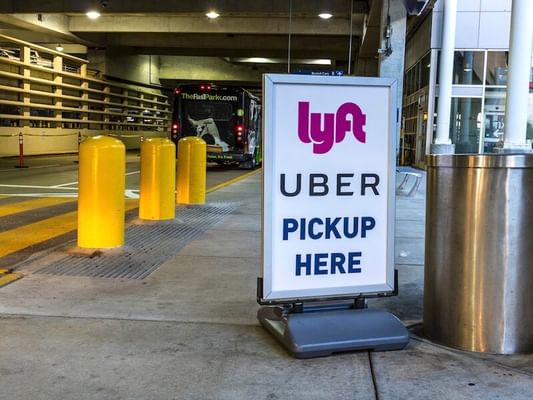- Undergraduate
Bachelor's Degrees
Bachelor of ArtsBachelor of EngineeringDual-Degree ProgramUndergraduate AdmissionsUndergraduate Experience
- Graduate
Graduate Experience
- Research
- Entrepreneurship
- Community
- About
-
Search
All Thayer News

New Mathematical Pricing Model Can Help Public and Private Transportation Systems Work Together So Everyone Wins
Feb 12, 2025 | by Catha Mayor
Operations researchers have developed a fare-setting model designed to optimize alliances between public transit agencies and private ride-sharing companies. The model, presented jointly by MIT, Dartmouth, and Northeastern and published in Transportation Science, could not only improve service quality and coverage for underserved communities, but also reduce costs for everyone while increasing efficiency.

Lyft and Uber pickup spot at the Indianapolis airport. (Photo by jetcityimage)
For the past decade, cities have struggled to match their transit infrastructure with the needs and patterns of a growing number of commuters. The result has been a steady increase in both traffic congestion and greenhouse gas emissions. A big part of this challenge is the existence of transit deserts—low-density areas disconnected from public transit. Well-established ride-sharing apps like Uber and Lyft have the potential to fill these gaps—in a way that aligns with transit agency goals—if given the right incentives.
"We show that using the right math and algorithms, you can design a transportation system that incentivizes for-profit on-demand companies to make decisions that benefit society as a whole," said Vikrant Vaze, a professor of engineering at Dartmouth and second author on the study. "Using our model, you can actually tell someone who wants to make money, 'Hey, here is a way to make more money, and also help people!'"
Despite ongoing pressure on public transit operators to do more for underserved areas, their systems have yet to recover from the COVID pandemic. Service was cut and lines were eliminated and never restored. "So it's a really tough environment for a public transit agency to commit to expanding its service," said Vaze.
What many cities need is a way for the already successful on-demand ride-sharing services to help people in transit deserts access the nearest public transit station. However, that requires complex coordination between two completely separate operating entities.
Explained Vaze, "So we're saying, what if you offer a fixed price for all rides to this public transit stop, and tell Uber and Lyft that if they make a loss on that, they'll be compensated. Uber and Lyft are guaranteed not to lose money while they benefit people and greater society, which is also good PR."
Facilitating long-term coordination between these two entities requires a stable pricing system that's affordable for the user, distributes sufficient profit to the on-demand companies, and gives the remaining money to the public transit. The research team—made up of Vaze, Kayla Cummings, PhD candidate at MIT, Özlem Ergun, professor of mechanical and industrial engineering at Northeastern, and Cynthia Barnhart, provost and professor of management science and operations research at MIT—designed their model not only to provide the algorithms needed to make that win-win-win scenario happen, but also to enable customization for achieving a variety of societal goals such as maximizing passenger convenience, minimizing pollution, or reducing the number of single-occupancy vehicles.
"What we found is that, yeah, we can make it work," said Vaze. "With the right computational methods, we can ensure that all parties benefit."
For contacts and other media information visit our Media Resources page.
